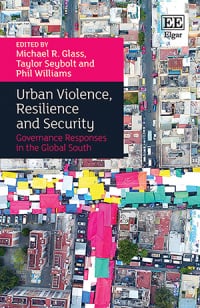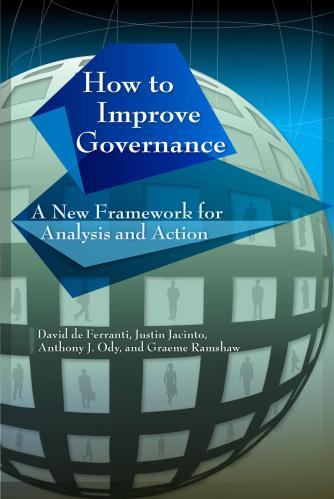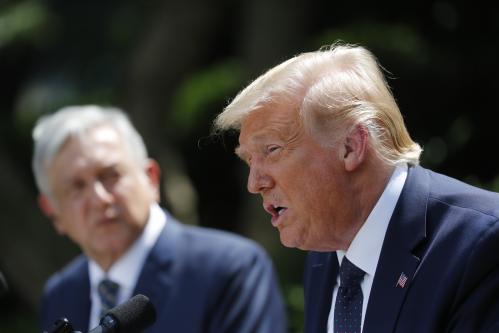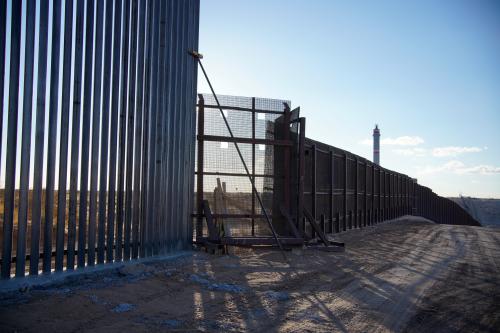Vanda Felbab-Brown discusses the water-resource stressors that are growing in U.S.-Mexican border areas, which have been experiencing water shortages for decades and will increasingly experience them as water availability plummets and becomes more unpredictable. This piece was originally published by La Reforma’s Mexico Today.
For weeks, a water dispute between the Mexican government and Mexican farmers and between the United States and Mexico was brewing and escalating. October 24 was the deadline by which Mexico was supposed to have provided the United States with all of the water from the Rio Grande it owes the United States every five years. But this year’s expected water delivery set off months-long protests in Chihuahua, where drought-stricken farmers took over the Boquilla dam and opposed the water disbursement to the United States, fearing that even more of their livestock and crops would perish. Unlike previous Mexican administrations that since mid-1990s habitually failed to deliver the Rio Grande water to the United States on time, President Andrés Manuel López Obrador (AMLO) has been determined to send the water to the United States. He even deployed the Mexican National Guard to confront the farmers and protestors, with the Guard killing one of them. At the last minute, a deal was struck between the two countries to resolve the latest immediate water crisis.
The recent tensions are merely the latest episode of accumulating water stress in the Rio Grande basin. Deep challenges of long-standing water overuse and depletion in the Rio Grande remain. The problem requires comprehensive and innovative solutions as well as major changes to agricultural and other water-use practices on both sides of the Rio Grande basin to preserve adequate water supply for people, food production, economic activity, and a vital biodiversity-rich ecosystem and to prevent the emergence of systematic theft and smuggling of water that plagues countries such as Pakistan, India, Nigeria, and Brazil. The U.S.-Mexico collaboration on innovative solutions for the Colorado River provides an important example.
Two U.S.-Mexico treaties – one agreed to in 1906 and one in 1944 – govern the shares and distribution of water between the two countries from the Rio Grande River, known in Mexico as the Rio Bravo, and the Colorado River basins. The 1906 treaty deals with the northwest portion of the Rio Grande basin – until Fort Quitman – and specifies that the United States annually delivers 60,000 acre-feet (74 million cubic meters) of water to Mexico, but allows for reductions in drought years. Those reductions do not accumulate as a water debt the United States must pay up later. Between 1939 and 2015, there have been reductions in U.S. delivery one-third of the time, with only about 6 percent of the amount delivered to Mexico during a major drought in 2013.
Southeast downstream from Fort Quitman, the sharing of water in the Rio Grande watershed is governed by the 1944 Treaty on Utilization of Waters of the Colorado and Tijuana Rivers and of the Rio Grande. Administered by the binational International Boundary and Water Commission (IBWC), that treaty specifies that the United States must deliver a minimum of 1.5 million acre-feet of water to Mexico annually from the Colorado River. Meanwhile, Mexico must deliver to the United States a minimum of 350,000 acre-feet of water annually from the Mexican tributaries of the Rio Grande. But the water deliveries are measured in five-year cycles, giving Mexico the flexibility of not always having to deliver the full 350,000 acre-feet each year, particularly in drought years, but being obligated to deliver the full 1.75 million acre-feet by the end of the five-year cycle. In practice, Mexico has repeatedly missed making the water payment during the five-year cycle, letting it slip into the following cycle and paying up only after large storms replenished the water supply. In contrast, the United States allocates the Colorado water delivery to Mexico first, before internal U.S. allocations are made each year. (But for decades Mexico has complained about the salinity of the Colorado River deliveries, getting the United States to adopt various remedial measures.)
The water deliveries and their delays set off hot politics. In 2013, hammered by a major drought, Texan farmers were infuriated by the Mexican water disbursement delays – akin to the fury of the Chihuahua farmers suffering from the current drought there, with the difference being that international law was on the side of the U.S. farmers. Mexico then repaid the water debt in 2016, but has been running a major water deficit since. Yet because intense rainfall has brought plenty of water to Texas farmers this year, the U.S. pressure on Mexico has been nowhere as intense as during the 2013 drought (even though Texas governor Greg Abbott and a few other politicians tried to make political hay out of the approaching deadline). Nonetheless, with good justification, there were legal concerns about Mexico violating its treaty obligations for a second five-year cycle in a row.
On the Mexican side, the politics were hotter and more surprising. Although a populist nationalist politician, President López Obrador not only maintained his approach of yielding to the United States on issue after issue, but also criticized and dismissed the protesting Mexican farmers and blamed the social strife on “big agriculture.” Big agriculture in Mexico is indeed a notorious thief of water, failing to pay water dues and depleting water in Mexico over allocated quotas. But small Mexican farmers are hurting from water stress and often have no voice in water policy decisions.
Unlike in the United States where both surface and ground water is owned by many entities (including state and local governments) and private actors (including individual and corporate land owners), in Mexico, water is owned by the Mexican state. The extremely complex system of water rights and their wide variation across jurisdictions on the U.S. side create lengthy and often difficult policymaking and enforcement tangles, but they also force water decision-making processes that involve consultation and problem-solving with all stakeholders. On the Mexican side, water decision-making is set by one institution – Comisión Nacional del Agua (Conagua) – and is heavily centralized, top-down, and insufficiently consultative and respectful of the interests of the varied stakeholders. As a result, some Mexican farmers do not even know that the 1944 treaty exists or what it says: Instead, they talk of water belonging to all.
Systematically ignoring the needs of small Mexican farmers can thrust them into the hands of “water mafias” — criminal groups that siphon off water in particular localities and illegally sell it at inflated prices to industries, big agriculture, and marginalized users, whether slum residents or small farmers. Such water mafias operate from South and Southeast Asia to Africa and the Middle East to Latin America. In Mexico, water theft has been more disorganized, but large Mexican criminal groups, particularly those with experience in oil theft and illegal sale of gasoline, can easily expand into water theft and smuggling.
Despite the resolution of the current crisis, water stress is growing in the U.S.-Mexican border areas. The U.S. Southwest and Mexican states at the border have been experiencing water shortages for decades and will increasingly experience them as water availability plummets and becomes more unpredictable.
Agriculture takes up 75 percent of water consumption in the U.S. Southwest and on the Mexican side. Energy production, industry and water-thirsty fracking are other major draws. Water is also needed for human consumption, with the population in the Rio Grande and Colorado River Basins expanding dramatically in recent decades. Global warming has reduced water flows, as replenishing snow packs in mountainous headwaters melt earlier and faster and accumulate less. Global warming has also resulted in decreased rain and increased evaporation, intensifying droughts. Cumulatively, these changes have reduced water supply while demand has grown much beyond what was envisioned in 1944. The depletion is putting enormous stress on the water basins and has decimated the river ecosystems that are necessary for sustainable hydrological functioning of the basins.
In addition to being potentially in violation of the 1944 treaty prohibitions of unilateral erection of any obstruction of the Rio Grande’s flow, the building of the border wall by the Trump administration is further hurting the rivers and basins and threatens dangerous flooding. The wall construction can also damage some of the 20 pan-border aquifers (not regulated by any treaty), already massively under stress by poorly monitored, poorly regulated and excessive use. The damage the wall construction has caused to the environmentally precious San Bernandino Springs and aquifer is a case in point.
The immediate resolution of the crisis is sound, and takes into account the needs of Mexican farmers: Mexico’s water delivery schedule has become even more flexible and there is also new flexibility permitting that water for the United States can be made from a wider set of water sources, thus taking pressure off Chihuahua. The United States will also help supply water to Chihuahua when needed in drought emergencies.
Further collaboration and deep changes are needed. Much can be learned from the U.S.-Mexican collaboration on updating the water distribution from the Colorado River, known as Minute 323 of 2017 and Minute 319 of 2012 of the 1944 water treaty. They include a “Mexican Water Reserve” in Lake Mead through which Mexico can choose to delay the U.S. distribution of water to the country and store it in the United States, thus increasing water elevation at Lake Mead – an outcome beneficial to U.S. and Mexican users and the environment. With the water level at Lake Mead used as baseline for determining shortage conditions and cutbacks in distributions, Mexico now shares in the cutbacks along with Arizona, California, and Nevada. The negotiated Minutes also include a recognition of the natural environment as a water user ( a global breakthrough), and the provision of environmental flows to restore riverine habitats in Mexico, with the United States financing the flows and environmental restoration in exchange for water stored at Lake Mead. A Binational Water Scarcity Contingency Plan has also been established. In many ways, the Minutes are a hallmark of creative binational and subnational collaboration, and a non-zero-sum approach to commons issues.
Beyond learning from the management of the Colorado River, long-term sustainable solutions to water supply from the Rio Grande require a set of policy actions:
First, they require binational and subnational collaboration with all local, state, and federal stakeholders and establishment of common policy objectives and a joint understanding of ground realities.
Second, they require identification and development of new water sources, such as through desalination or conduction of water from more humid areas. Locating new water sources is often the preferred solution of water users and some water managers. It is necessary, but insufficient.
Third, and critically, water conservation and reuse must become key strategies at the Rio Grande and globally. This includes moving away from inefficient agricultural practices to water-savvy ones, such as the greater use of greenhouses and drip irrigation, and adopting Nature-Based Solutions.
Fourth, groundwater must stop being the undervalued, underpriced fallback to and enabler of surface water overuse and unsustainable economic practices. On neither side of the border, whether Arizona or Chihuahua, it makes sense to grow water-thirsty crops like pecans in the desert by flooding desert soil in prime heat times with water pumped out of poorly monitored and likely rapidly shrinking aquifers.
Fifth, studying, monitoring, and regulating aquifers and groundwater use, a domain in which California has taken initial baby steps, is necessary in each country separately and binationally.
Sixth, explicitly recognizing the water needs of ecosystems and the hydrological services they provide to nature and people is critical.
Seventh, to better align economic decisions with water sustainability, water must be adequately priced according to a pricing schedule escalating with water use; and serious, if very difficult, rethinking needs to be done about water rights allocation for groundwater.
Finally, such a commons approach to the Rio Grande water sustainability needs dedicated enforcement on both sides of the border: Usage and payments need to be policed, and water use violating regulations punished. Enforcing water regulations in turn requires technological innovation, increased resources for enforcement, and greater will to enforce regulations domestically, including through stiffer and reliably frequent penalties – as well as problem solving. It also demands joint determination to make binational and local arrangements work.
The Brookings Institution is committed to quality, independence, and impact.
We are supported by a diverse array of funders. In line with our values and policies, each Brookings publication represents the sole views of its author(s).











Commentary
Not dried up: US-Mexico water cooperation
October 26, 2020